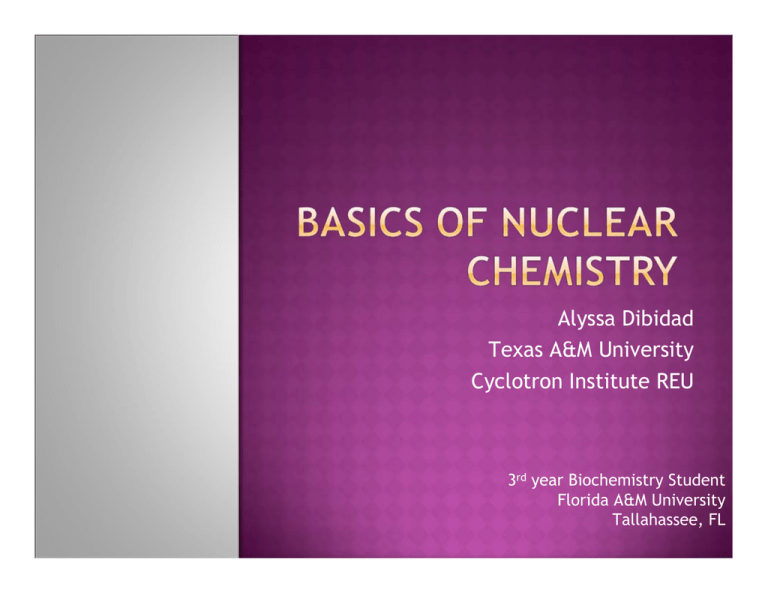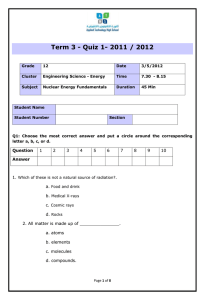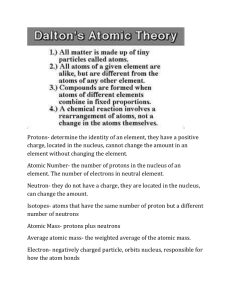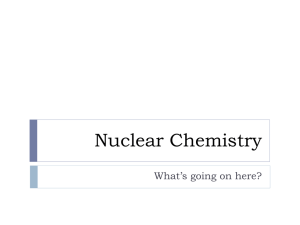
Alyssa Dibidad
Texas A&M University
Cyclotron Institute REU
3rd year Biochemistry Student
Florida A&M University
Tallahassee, FL
What
is Chemistry?
The Basics
The Atom and Atomic Structure
Elements and the Periodic Table
What
is Nuclear Chemistry?
Radioactivity
Isotopes and the Chart of the Nuclides
Decays
Alpha, Beta, and Gamma
Half-life
What
we do at the Cyclotron
Chemistry
is the study of matter
and the changes that it can
undergo
Matter is anything that has mass
and takes up space
Can be made up of pure or a
mixture of pure substances in any
state
The smallest unit of matter is the
atom
Lithium Atom
The
goal of chemistry is to understand atomic
and molecular interactions – both naturally and
synthetically
Very
basic
structure
Mostly empty
space
Radius measured
in picometers
(10-12 m)
Electron
Cloud
Nucleus
1 femtometer = 10-15 m
6 electrons,
6 protons,
6 neutrons
13 electrons,
13 protons,
14 neutrons
Atoms differ depending upon the number of protons
in the nucleus and as they are discovered, they are
named and become elements
Each element is given an atomic number which
corresponds with its proton number
They are now organized by increasing atomic
number in the Periodic Table of Elements
C
6
Nuclear
Chemistry is the division dealing with
the atomic nucleus, radioactivity, and
nuclear reactions
Radioactivity - the spontaneous emission of
a stream of particles or electromagnetic rays
in nuclear decay
Any atom with
84 or more
protons is
radioactive
12
6
C
Atomic Mass (A)
Atomic Number (Z)
Atomic Mass = Proton Number + Neutron Number
27?
13
Al
Aluminum: 13 p+, 13 e-, 14 n0
Atoms
of the same element may have
different neutron numbers, thus different
mass numbers
12
6
14
6
C
C
Carbon-12
Carbon-14
6 electrons,
6 protons,
6 neutrons
6 electrons,
6 protons,
8 neutrons
We organize all the known isotopes of the elements
into another chart, called the Chart of the Nuclides
Nuclear reactions
involve changes in an
atom’s nucleus
Isotopes with an
unstable nucleus are
radioactive and will
spontaneously undergo
a nuclear reaction
A stable isotope will not
spontaneously undergo
a nuclear reaction
Different isotopes
undergo different types
of changes
A nucleus will gain or
lose protons and/or
neutrons
High energy particles or
electromagnetic
radiation will be given
off
The new atom may be
stable or radioactive
Several types of
reactions
When
a nucleus undergoes α decay, it loses 2
protons and 2 neutrons
A new element is produced, with an atomic
number 2 less than and an atomic mass 4 less
than the original
Uranium-238 into Thorium-234
There
are 2 types of Beta Decay
β‐ decay
β+ decay also called positron emission
In
β- decay, a neutron decomposes into a proton
and a beta particle
In β+ decay a proton is converted to a neutron
and a positron
Occurs
when there are too many neutrons
A neutron decomposes into a proton,
antineutrino, and a beta particle (electron)
Carbon-14 into Nitrogen-14
Occurs
when there are too many protons
A proton is converted to a neutron,
neutrino, and a positron (a positive electron)
Carbon-10 into Boron-10
Emission
of high energy electromagnetic
radiation from an excited nucleus
Often occurs with alpha or beta decay as a
way to release energy
The
time required for ½ of the atoms in a
sample to emit radiation and decay
Half-lives differ, from nanoseconds to years
Calculated using
where λ is the
decay constant
The
Cyclotron is a particle accelerator
Accelerates charged particles using a high-frequency,
alternating voltage, and a magnetic field
The
Cyclotron produces a beam of particles that
we can use to shoot at other particles to create
and study isotopes and measure decays
Brown, Theodore L., H. Eugene, Jr. LeMay, and Bruce
E. Bursten. Chemistry: The Central Science. Upper
Saddle River, NJ: Pearson, Prentice Hall, 2006.
Ferbel, A. Das and T. Introduction to Nuclear and
Particle Physics. New Jersey: World Scientific, 2003.
Koutroulis. "Introduction to Nuclear Chemistry." 2006.
http://faculty.riohondo.edu/mkoutroulis/chem110/N
otes/Introduction%20to%20Nuclear%20Chemistry%20N
otes.pdf (accessed June 30, 2009).
Nuclear Chemistry. 2009.
http://www.wiziq.com/tutorial/17899-Nuclearchemistry-presentation (accessed June 30, 2009).






